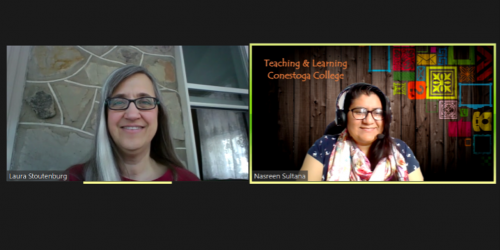
Icebreakers for Your Zoom Classrooms
In the era of synchronous online learning, it is important to create a community of learning. Using icebreakers can foster communities, promote positive teacher and student relationships, and lay the groundwork for classroom interaction (Serembus & Kemery, 2020). Studies in pedagogy encourage teachers to use icebreakers in their classes. The following icebreakers are quick and easy to run both in the big and small Zoom and in-person classroom.
Before trying many of these suggestions, make sure you’re familiar with creating and managing breakout rooms.
Count the numbers from 1 to 10
Purpose and duration: This icebreaker can be done with a bigger group, and it is possible to wrap it up within 5 to 6 minutes, leaving everyone with smiles. This is a good icebreaker when people do not know each other.
Process: Request everyone to unmute their mic and come on camera if possible. Give students a minute to be ready for the game. The idea is that participants in the session will try to count from 1 to 10, making sure that no two students utter a number simultaneously. For example, once you say “1”, someone else from the class will say 2, then someone else will say 3, but the moment more than one student utter the same number simultaneously, you will restart the counting from 1. This can go for a few rounds. Play this game with a smile on your face and enjoy students’ smiles too.
Draw your mood
Purpose and duration: This icebreaker makes students loosen up a little and allows them to be silly. It is possible to complete this activity within 5 to 6 minutes.
Process: Share the Zoom whiteboard and ask the students to draw their mood using the annotation option. Of course, make sure that they know how to use annotation. Students will draw randomly silly things and as they draw, keep interacting with them. Some of them might want to use the chat option, too, while you keep interacting with them.
Tag my friends
Purpose and duration: This icebreaker creates a quick class connection. Even with a large class size, it is possible to wrap up this activity within 6 to 7 minutes.
Process: The idea is one student will tag another student from the class by taking their name on the mic. The student whose name is taken will say “hello” and tag another student. The game will continue until all the students are tagged. If the student whose name is taken is already tagged, they will say, “pass” and take another name. This will allow you to know the pronunciation of everyone’s name.
Never have I ever
Purpose and duration: This is a fun icebreaker and will help you to establish a quick class connection. It is possible to wrap up the activity within 6 to 7 minutes.
Process: On the slide, you put statements, such a “never have I ever bunked any class in my life,” or any funny and interesting prompts. You will share one prompt at a time, and students will say yes or no in the chat. You may want to share five prompts with the students, but make sure that you share one prompt at a time. Keep interacting with the students as they keep posting in the chat.
Two truths and a lie
Purpose and duration: The game helps people to share a bit of themselves, and students start knowing each other. This icebreaker usually takes longer but uses a name picker wheel to let 5 to 6 students play in each class. In this way, you can play this icebreaker in multiple sessions. This icebreaker can be completed within 10 minutes if you play only with a few students.
Process: First, put everyone’s name on a name picker wheel and then screen share the wheel. Tell students to be ready with two true statements and a lie statement. Start the game with you, and as you provide students with three statements, they will guess which one is fake. Then with the help of the name picker wheel, play this game with five random students, and other students share their guesses via chat.
The same game can be played in the breakout room as well. However, you will not be able to present in the rooms.
Making a movie
Purpose and Duration: Students from South Asia love movies, and they love talking about movies as well. It is also a good ice breaker for students if you want them to talk to each other, teach about collaboration, communication, and research. However, you will need at least 15 to 20 minutes to complete the game.
Process: Put students in a group of 4 or 5 and ask them to come up with an idea of a movie that they want you to produce. They need to decide on a person who will present the idea in the main room. Then, send them to breakout rooms with 7 to 8 minutes. Visit the breakout rooms so that you can guide them. Once they are back to the main room, the spoke person could share the idea, and other students can give reactions only by using the “heart,” “clap” or “thumbs up” sign. You can do this activity before initiating any more significant assignments.
About me
Purpose and Duration: This one is a quick icebreaker to find out more about the students. Students get to find a lot about each other, and you will have a chance to know your students as well. You will use Mentimeter to complete the activity. This activity is possible to wrap up within 5 to 6 minutes.
Process: Use simple questions, such as, what’s your favourite movie, why did you choose Canada, why did you choose this course, what do you want to be, what’s your hobby, what’s your favourite sport, or any other question that you want to use. Share the code with the students and give them a couple of minutes to answer the question(s). To save time, I will suggest use two questions each time you play this activity. You will see the commonalities among the students. This will be equally valuable when the students see how common their answers were. Finally, wrap up the activity with your observations or with one or two follow-up questions.
Always run the icebreakers with a positive and interactive tone. The students need to feel that you are equally invested in this activity. Once the activity is done, always tell them what the class or you earned/learned by doing the activity.
References:
Serembus, J. F., & Kemery, D. (2020). Creating Dynamic Learning With Zoom. Nurse Educator, 45, 291-293. https://doi.org/10.1097/NNE.0000000000000915







2 Responses